2005 CHEVROLET MALIBU door lock
[x] Cancel search: door lockPage 1 of 434

Seats and Restraint Systems........................... 1-1
Front Seats
............................................... 1-2
Rear Seats
............................................... 1-8
Safety Belts
.............................................1-10
Child Restraints
.......................................1-33
Airbag System
.........................................1-60
Restraint System Check
............................1-75
Features and Controls..................................... 2-1
Keys
........................................................ 2-3
Doors and Locks
......................................2-11
Windows
.................................................2-16
Theft-Deterrent Systems
............................2-17
Starting and Operating Your Vehicle
...........2-21
Mirrors
....................................................2-33
OnStar
®System
......................................2-38
HomeLink®Wireless Control System
...........2-40
Storage Areas
.........................................2-44
Sunroof
..................................................2-47
Instrument Panel............................................. 3-1
Instrument Panel Overview
.......................... 3-4
Climate Controls
......................................3-21
Warning Lights, Gages, and Indicators
........3-30
Driver Information Center (DIC)
..................3-47
Audio System(s)
.......................................3-54Driving Your Vehicle....................................... 4-1
Your Driving, the Road, and Your Vehicle
..... 4-2
Towing
...................................................4-34
Service and Appearance Care.......................... 5-1
Service
..................................................... 5-3
Fuel
......................................................... 5-5
Checking Things Under the Hood
...............5-10
Bulb Replacement
....................................5-41
Windshield Wiper Blade Replacement
.........5-45
Tires
......................................................5-47
Appearance Care
.....................................5-73
Vehicle Identi�cation
.................................5-82
Electrical System
......................................5-83
Capacities and Speci�cations
.....................5-91
Maintenance Schedule..................................... 6-1
Maintenance Schedule
................................ 6-2
Customer Assistance and Information.............. 7-1
Customer Assistance and Information
........... 7-2
Reporting Safety Defects
...........................7-10
Index................................................................ 1
2005 Chevrolet Malibu Owner ManualM
Page 22 of 434
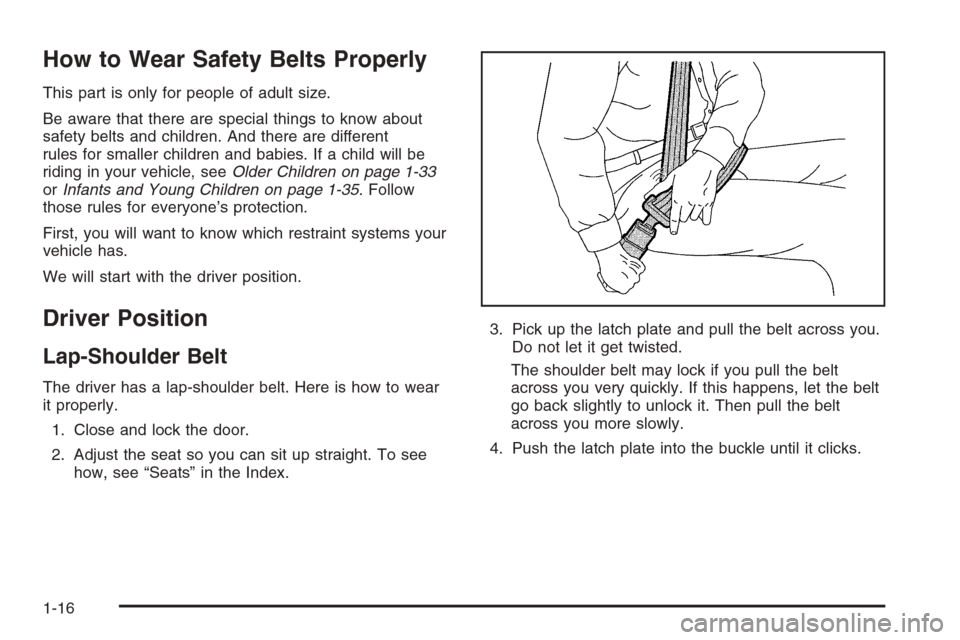
How to Wear Safety Belts Properly
This part is only for people of adult size.
Be aware that there are special things to know about
safety belts and children. And there are different
rules for smaller children and babies. If a child will be
riding in your vehicle, seeOlder Children on page 1-33
orInfants and Young Children on page 1-35. Follow
those rules for everyone’s protection.
First, you will want to know which restraint systems your
vehicle has.
We will start with the driver position.
Driver Position
Lap-Shoulder Belt
The driver has a lap-shoulder belt. Here is how to wear
it properly.
1. Close and lock the door.
2. Adjust the seat so you can sit up straight. To see
how, see “Seats” in the Index.3. Pick up the latch plate and pull the belt across you.
Do not let it get twisted.
The shoulder belt may lock if you pull the belt
across you very quickly. If this happens, let the belt
go back slightly to unlock it. Then pull the belt
across you more slowly.
4. Push the latch plate into the buckle until it clicks.
1-16
Page 29 of 434
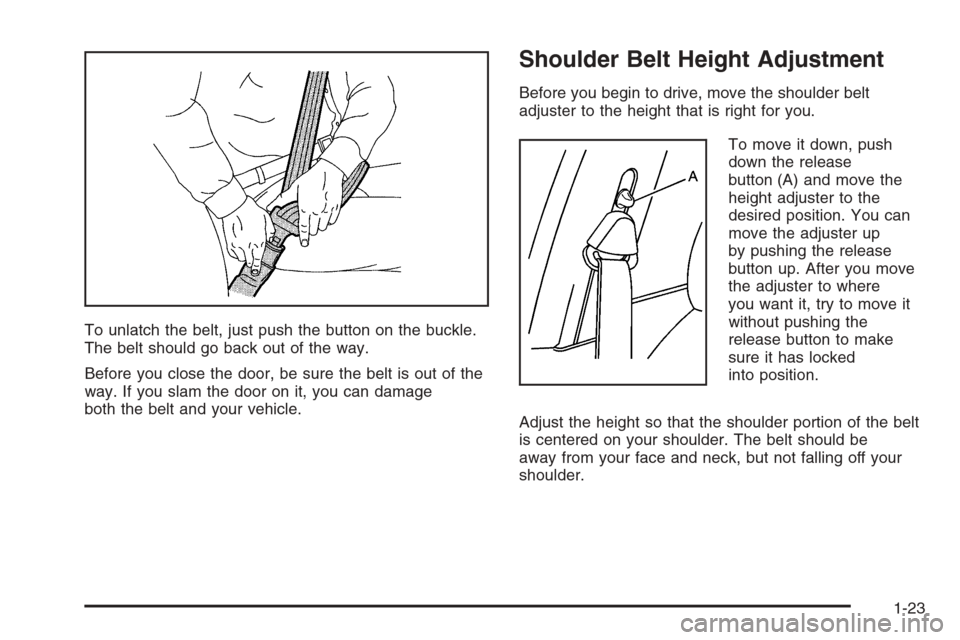
To unlatch the belt, just push the button on the buckle.
The belt should go back out of the way.
Before you close the door, be sure the belt is out of the
way. If you slam the door on it, you can damage
both the belt and your vehicle.
Shoulder Belt Height Adjustment
Before you begin to drive, move the shoulder belt
adjuster to the height that is right for you.
To move it down, push
down the release
button (A) and move the
height adjuster to the
desired position. You can
move the adjuster up
by pushing the release
button up. After you move
the adjuster to where
you want it, try to move it
without pushing the
release button to make
sure it has locked
into position.
Adjust the height so that the shoulder portion of the belt
is centered on your shoulder. The belt should be
away from your face and neck, but not falling off your
shoulder.
1-23
Page 71 of 434
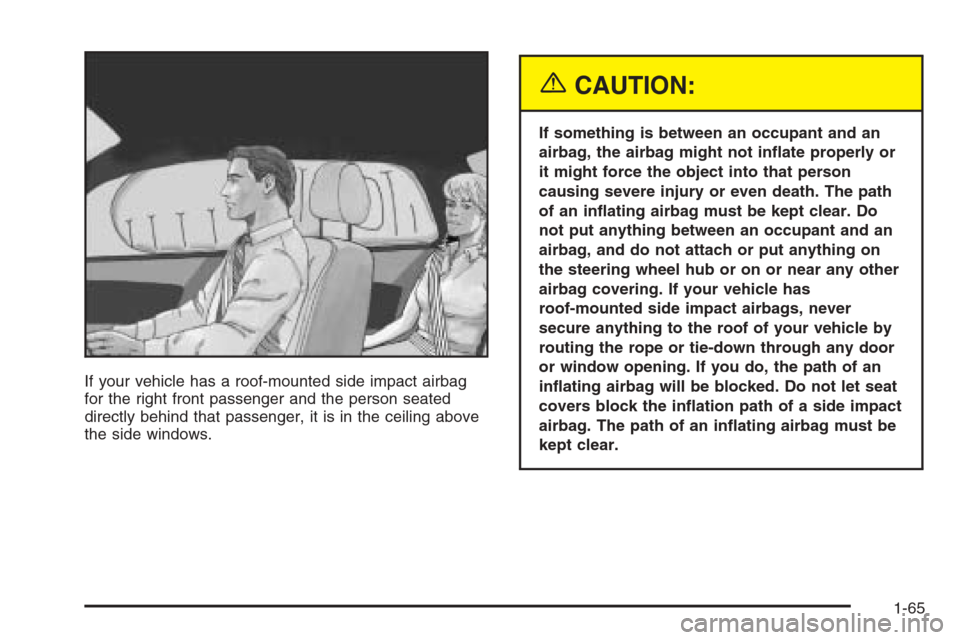
If your vehicle has a roof-mounted side impact airbag
for the right front passenger and the person seated
directly behind that passenger, it is in the ceiling above
the side windows.
{CAUTION:
If something is between an occupant and an
airbag, the airbag might not in�ate properly or
it might force the object into that person
causing severe injury or even death. The path
of an in�ating airbag must be kept clear. Do
not put anything between an occupant and an
airbag, and do not attach or put anything on
the steering wheel hub or on or near any other
airbag covering. If your vehicle has
roof-mounted side impact airbags, never
secure anything to the roof of your vehicle by
routing the rope or tie-down through any door
or window opening. If you do, the path of an
in�ating airbag will be blocked. Do not let seat
covers block the in�ation path of a side impact
airbag. The path of an in�ating airbag must be
kept clear.
1-65
Page 83 of 434
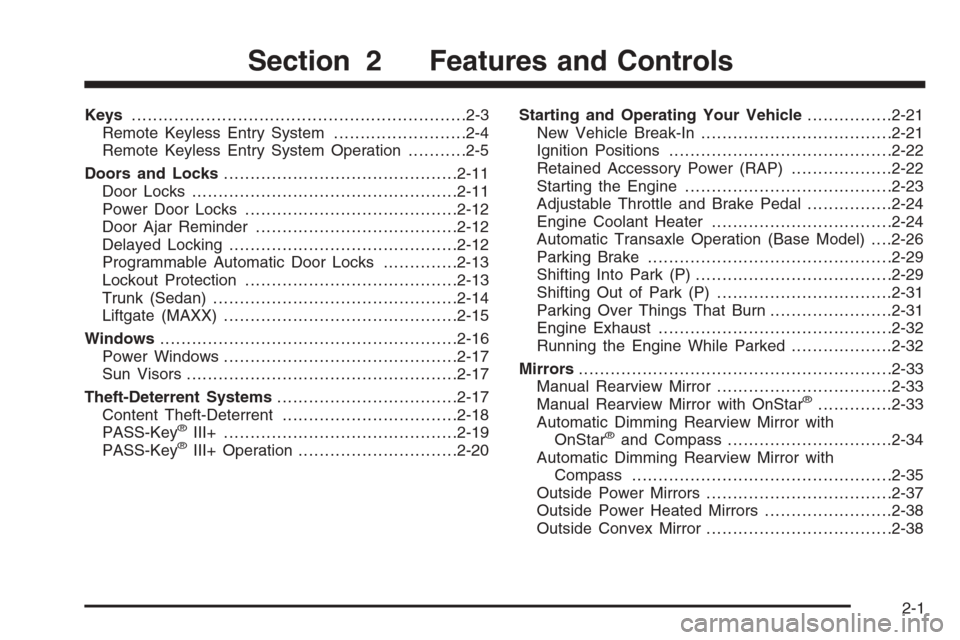
Keys...............................................................2-3
Remote Keyless Entry System.........................2-4
Remote Keyless Entry System Operation...........2-5
Doors and Locks............................................2-11
Door Locks..................................................2-11
Power Door Locks........................................2-12
Door Ajar Reminder......................................2-12
Delayed Locking...........................................2-12
Programmable Automatic Door Locks..............2-13
Lockout Protection........................................2-13
Trunk (Sedan)..............................................2-14
Liftgate (MAXX)............................................2-15
Windows........................................................2-16
Power Windows............................................2-17
Sun Visors...................................................2-17
Theft-Deterrent Systems..................................2-17
Content Theft-Deterrent.................................2-18
PASS-Key
®III+............................................2-19
PASS-Key®III+ Operation..............................2-20Starting and Operating Your Vehicle................2-21
New Vehicle Break-In....................................2-21
Ignition Positions..........................................2-22
Retained Accessory Power (RAP)...................2-22
Starting the Engine.......................................2-23
Adjustable Throttle and Brake Pedal................2-24
Engine Coolant Heater..................................2-24
Automatic Transaxle Operation (Base Model). . . .2-26
Parking Brake..............................................2-29
Shifting Into Park (P).....................................2-29
Shifting Out of Park (P).................................2-31
Parking Over Things That Burn.......................2-31
Engine Exhaust............................................2-32
Running the Engine While Parked...................2-32
Mirrors...........................................................2-33
Manual Rearview Mirror.................................2-33
Manual Rearview Mirror with OnStar
®..............2-33
Automatic Dimming Rearview Mirror with
OnStar
®and Compass...............................2-34
Automatic Dimming Rearview Mirror with
Compass.................................................2-35
Outside Power Mirrors...................................2-37
Outside Power Heated Mirrors........................2-38
Outside Convex Mirror...................................2-38
Section 2 Features and Controls
2-1
Page 87 of 434
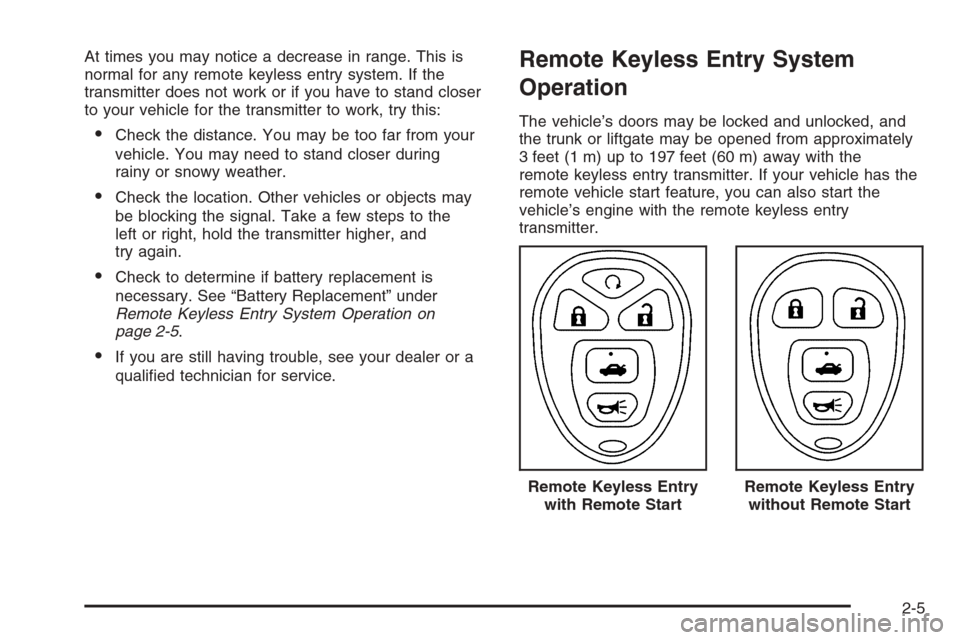
At times you may notice a decrease in range. This is
normal for any remote keyless entry system. If the
transmitter does not work or if you have to stand closer
to your vehicle for the transmitter to work, try this:
Check the distance. You may be too far from your
vehicle. You may need to stand closer during
rainy or snowy weather.
Check the location. Other vehicles or objects may
be blocking the signal. Take a few steps to the
left or right, hold the transmitter higher, and
try again.
Check to determine if battery replacement is
necessary. See “Battery Replacement” under
Remote Keyless Entry System Operation on
page 2-5.
If you are still having trouble, see your dealer or a
quali�ed technician for service.
Remote Keyless Entry System
Operation
The vehicle’s doors may be locked and unlocked, and
the trunk or liftgate may be opened from approximately
3 feet (1 m) up to 197 feet (60 m) away with the
remote keyless entry transmitter. If your vehicle has the
remote vehicle start feature, you can also start the
vehicle’s engine with the remote keyless entry
transmitter.
Remote Keyless Entry
with Remote Start
Remote Keyless Entry
without Remote Start
2-5
Page 88 of 434

The following functions may be available if your vehicle
has the remote keyless entry system:
/(Remote Vehicle Start):If your vehicle has this
feature, the engine may be started from outside
the vehicle using the remote keyless entry transmitter.
See “Remote Vehicle Start” at the end of this section for
more detailed information.
Q(Lock):Press the lock button to lock all the doors.
The interior lamps will turn off after all of the doors
are closed. If enabled through the Driver Information
Center (DIC), the remote lock feedback can be
programmed to have the horn chirp and/or the parking
lamps �ash when the remote keyless entry transmitter
is used to lock the vehicle’s doors. See “LOCK HORN”
and “LIGHT FLASH” underDIC Operation and
Displays on page 3-47for more information.
Pressing the lock button may arm the content
theft-deterrent system. SeeContent Theft-Deterrent on
page 2-18.
K(Unlock):Press the unlock button to unlock the
driver’s door. If the button is pressed again within
�ve seconds, all remaining doors, and the liftgate will
unlock. The interior lamps will turn on and stay on
for 20 seconds or until the ignition is turned on.
If enabled through the DIC, the remote unlock feedback
can be programmed to have the horn chirp and/or
the parking lamps �ash when the remote keyless entry
transmitter is used to unlock the vehicle’s doors.
See “UNLOCK HORN” and “LIGHT FLASH” underDIC
Operation and Displays on page 3-47for more
information.
If enabled through the DIC, and it is dark enough
outside, the vehicle’s high-beam headlamps, parking
lamps, and back-up lamps will turn on each time
the unlock button on the transmitter is pressed. These
exterior lamps will stay on for 20 seconds, or until a door
is opened. See “EXT (Exterior) LIGHTS” underDIC
Operation and Displays on page 3-47.
Pressing the unlock button will disarm the content
theft-deterrent system, if equipped. SeeContent
Theft-Deterrent on page 2-18.
2-6
Page 93 of 434
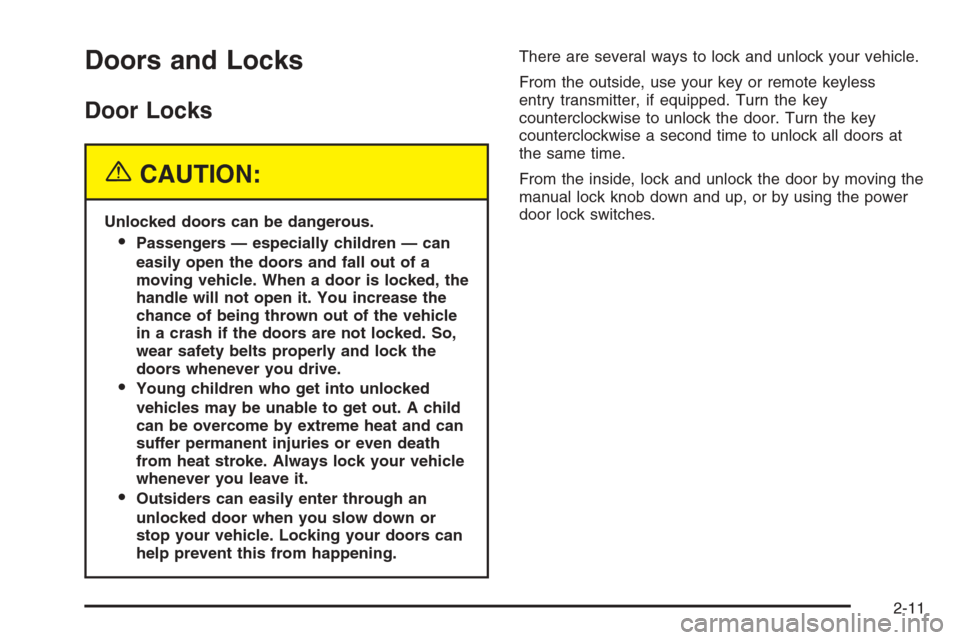
Doors and Locks
Door Locks
{CAUTION:
Unlocked doors can be dangerous.
Passengers — especially children — can
easily open the doors and fall out of a
moving vehicle. When a door is locked, the
handle will not open it. You increase the
chance of being thrown out of the vehicle
in a crash if the doors are not locked. So,
wear safety belts properly and lock the
doors whenever you drive.
Young children who get into unlocked
vehicles may be unable to get out. A child
can be overcome by extreme heat and can
suffer permanent injuries or even death
from heat stroke. Always lock your vehicle
whenever you leave it.
Outsiders can easily enter through an
unlocked door when you slow down or
stop your vehicle. Locking your doors can
help prevent this from happening.There are several ways to lock and unlock your vehicle.
From the outside, use your key or remote keyless
entry transmitter, if equipped. Turn the key
counterclockwise to unlock the door. Turn the key
counterclockwise a second time to unlock all doors at
the same time.
From the inside, lock and unlock the door by moving the
manual lock knob down and up, or by using the power
door lock switches.
2-11